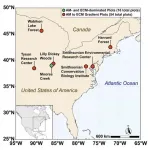A computational approach to understanding how infants perceive language
A multi-institutional team of cognitive scientists and computational linguists have developed computationally-based modeling approach that opens the path toward a much deeper understanding of early language acquisition
2021-01-29
(Press-News.org) Languages differ in the sounds they use. The Japanese language, for example, does not distinguish between "r" and "l" sounds as in "rock" versus "lock." Remarkably, infants become attuned to the sounds of their native language before they learn to speak. One-year-old babies, for example, less readily distinguish between "rock" and "lock" when living in an environment where Japanese, rather than English, is spoken.
Influential scientific accounts of this early phonetic learning phenomenon initially proposed that infants group sounds into native vowel- and consonant-like phonetic categories through a statistical clustering mechanism known as "distributional learning."
The idea that infants learn consonant- and vowel-like phonetic categories has been challenged, however, by a new study published this week in the Proceedings of the National Academy of Sciences.
In the study, a multi-institutional team of cognitive scientists and computational linguists have introduced a quantitative modeling framework that is based on a large-scale simulation of the language learning process in infants. Using computationally efficient machine learning techniques, this approach allows learning mechanisms to be systematically linked to testable predictions regarding infants' attunement to their native language.
"Hypotheses about what is being learned by infants have traditionally driven researchers' attempts to understand this surprising phenomenon," says Thomas Schatz, a postdoctoral associate in the University of Maryland of Maryland Institute for Advanced Computer Studies (UMIACS) who was lead author of the study. "We propose to start from hypotheses about how infants might learn."
In addition to Schatz, the study's authors include Naomi Feldman, an associate professor of linguistics at the University of Maryland with an appointment in UMIACS; Sharon Goldwater, a professor in the Institute for Language, Cognition and Computation at the University of Edinburgh's School of Informatics; Xuân-Nga Cao, a research engineer at Ecole Normale Supérieure (ENS) in Paris and co-founder of the Langinnov and Gazouyi startups; and Emmanuel Dupoux,a professor who directs the Cognitive Machine Learning team at ENS.
For their study, the researchers simulated the learning process in infants by training a computationally efficient clustering algorithm on realistic speech input. The algorithm was fed spectrogram-like auditory features sampled at regular time intervals that were obtained from naturalistic speech recordings in a target language. In this study, American English and Japanese were the two languages used.
This yielded a candidate model for the early phonetic knowledge of, say, a Japanese infant, the researchers say. Next, they asked two questions of the trained models. Could they explain the observed differences in how Japanese- and English-learning infants discriminate speech sounds? And, did the models learn vowel- and consonant-like phonetic categories?
The dominant scientific accounts of early phonetic learning would have expected the answers to these questions to match (either both should be "yes" or both should be "no"). The researchers found that the answer to the first question was positive: Their models did account for infants' observed behavior, in particular for the Japanese infants' difficulty with distinguishing words like "rock" and "lock." The answer to the second question, however, was negative: The models were found to have learned speech units too brief and acoustically variable to correspond to vowel- and consonant-like phonetic categories.
These results suggest a striking reinterpretation of the existing literature on early phonetic learning. Difficulties in scaling up distributional learning of phonetic categories to realistic learning conditions may be better interpreted as questioning the idea that what infants learn are phonetic categories, rather than the idea that how infants learn is through pure distributional learning (the traditional interpretation).
Cognitive science has not traditionally made use of such large-scale modeling, says Schatz, but recent advances in computing power, large datasets, and machine-learning algorithms make this approach more feasible than ever before.
Schatz and Feldman are part of the Computational Linguistics and Information Procession (CLIP) Laboratory in UMIACS, where Feldman is the current director. The robust computing resources in the CLIP lab and the Cognitive Machine Learning lab in Paris were instrumental to the research project, Feldman says.
In conclusion, the researchers believe their computationally-based modeling approach--together with ongoing efforts in the field to collect empirical data on a large scale, such as large-scale recordings of infants' learning environments at home and large-scale assessment of infants' learning outcomes--opens the path toward a much deeper understanding of early language acquisition.
INFORMATION:
The research paper, "Early phonetic learning without phonetic categories - Insights from large-scale simulations on realistic input," was published on January 28, 2021, in the Proceedings of the National Academy of Sciences.
ELSE PRESS RELEASES FROM THIS DATE:
2021-01-29
Scientists have given a fascinating new insight into the next steps to develop fast, energy-efficient, future computing systems that use light instead of electrons to process and store information - incorporating hardware inspired directly by the functioning of the human brain.
A team of scientists, including Professor C. David Wright from the University of Exeter, has explored the future potential for computer systems by using photonics in place of conventional electronics.
The article is published today (January 29th 2021) in the prestigious journal Nature Photonics.
The ...
2021-01-29
East Hanover, NJ. January 29, 2021. A team of New Jersey researchers has demonstrated that high-dose therapy gait training using robotic exoskeletons may aid early rehabilitation for acute stroke. The article, "Robotic exoskeleton gait training during acute stroke inpatient rehabilitation" (doi: 10.339/fnbot.2020.581815), was published October 30, 2020 in Frontiers in Neurorobotics is available open access at: https://www.frontiersin.org/articles/10.3389/fnbot.2020.581815/full
The authors are Karen Nolan, PhD, Kiran Karunakaran, PhD, and Kathleen Chervin, of Kessler Foundation, Michael Monfett, MD, of Children's Specialized Hospital, Radhika Bapineedu, MD, and Neil N. Jasey Jr, MD, of Kessler Institute for Rehabilitation, and Mooyeon Oh-Park, MD, ...
2021-01-29
Coronary artery calcification -- the buildup of calcified plaque in the walls of the heart's arteries -- is an important predictor of adverse cardiovascular events like heart attacks. Coronary calcium can be detected by computed tomography (CT) scans, but quantifying the amount of plaque requires radiological expertise, time and specialized equipment. In practice, even though chest CT scans are fairly common, calcium score CTs are not. Investigators from Brigham and Women's Hospital's Artificial Intelligence in Medicine (AIM) Program and the Massachusetts General Hospital's Cardiovascular Imaging Research Center (CIRC) teamed up to develop and evaluate a deep learning system ...
2021-01-29
In the treatment of SARS-CoV-2, the virus that causes COVID-19, antiviral drug remdesivir has emerged as a promising candidate.
Remdesivir works by disrupting the virus's ability to replicate, but its exact mechanism has remained a mystery. Using advanced computational simulations, researchers at the Pritzker School of Molecular Engineering (PME) at the University of Chicago have revealed just how the drug works at the molecular level. They also found that two drugs that work in a similar manner, ribavirin and favilavir, do not bind as effectively to the virus.
"It's important to understand ...
2021-01-29
Researchers at the University of Maryland, Baltimore County (UMBC) have made strides in automated legal document analytics (ALDA) by creating a way to machine-process the Code of Federal Regulations (CFR). The CFR is a complex document containing policies related to doing business with the federal government. All business affiliates of the federal government must comply with the CFR. For government contracts to be equitably open to a broad range of businesses, policies within the CFR must be accessible.
This document automation is just one part of a broader project to help contractors and other entities manage and monitor ...
2021-01-29
COLUMBUS, Ohio - Nearly nine out of 10 Americans say they enjoy sports at least a little, but heterosexual men more commonly identify as passionate sports fans, a new study suggests.
A survey of nearly 4,000 American adults found that only 11% said they did not identify as sports fans at all. Over 40% were passionate fans, identifying themselves as being "quite a bit" or "very much so" sports fans.
About 60% of heterosexual men in the survey identified as passionate sports fans, compared to about 40% of both heterosexual women and lesbians. About 30% of gay men reported being passionate sports fans.
"We found that U.S. adults respond overwhelmingly that they are sports fans," said Chris Knoester, co-author of the ...
2021-01-29
Trees are often heralded as the heroes of environmental mitigation. They remove carbon dioxide from the atmosphere, which slows the pace of climate change, and sequester nutrients such as nitrogen, which improves water and air quality.
Not all tree species, however, perform these services similarly, and some of the strongest impacts that trees have on ecosystems occur below the surface, away from the eyes of observers. This complicates efforts to predict what will happen as tree species shift owing to pests, pathogens, and climate change as well as to predict which species are most beneficial in reforestation ...
2021-01-29
Parents know the scenario all too well: their child misbehaves and it comes time for discipline.
Research conducted globally shows that spanking is not the best option. But verbal reasoning, which explains why the behavior is wrong, may not always have the intended positive effect if the parent is loud and abrupt, according to a new University of Michigan study.
The findings indicate both positive and negative outcomes that could have lasting consequences on children's emotional development. Verbal reasoning was associated with higher levels of getting along with others, but also with increased aggression and higher levels of distraction.
"Positive discipline doesn't always seem to have all that many positive benefits," ...
2021-01-29
Another wave of COVID-19 is putting millions out of work, while tens of millions more remain unemployed, and Congress debates aid.
Now, a new Boston University School of Public Health (BUSPH) study shows that unemployment help directly translates to people being able to put food on the table.
The CARES Act--passed in March of 2020-- expanded unemployment insurance coverage, amount, and duration.
Published in JAMA Network Open, the study finds that receiving unemployment insurance cuts a person's risk of food insecurity by a third, and halves the likelihood of needing to eat less because of financial constraints. And receiving more coverage, such as the weekly $600 supplement included in CARES until last July, means an even bigger reduction in the risk of going hungry.
"There ...
2021-01-29
RICHLAND, Wash.?Unless radon gas is discovered in a home inspection, most people remain blissfully unaware that rocks like granite, metal ores, and some soils contain naturally occurring sources of radiation. In most cases, low levels of radiation are not a health concern. But some scientists and engineers are concerned about even trace levels of radiation, which can wreak havoc on sensitive equipment. The semiconductor industry, for instance, spends billions each year to source and "scrub" ultra-trace levels of radioactive materials from microchips, transistors and sensitive sensors.
Now chemists at the U.S. Department of Energy's Pacific Northwest National Laboratory have developed ...
LAST 30 PRESS RELEASES:
[Press-News.org] A computational approach to understanding how infants perceive language
A multi-institutional team of cognitive scientists and computational linguists have developed computationally-based modeling approach that opens the path toward a much deeper understanding of early language acquisition


